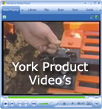Trail Rake
Cam Lockwood, trail coordinator for the Angeles National Forest in southern California, proposed that MTDC modify a flexible-tooth landscaping rake manufactured by York Modern Company. Lockwood wanted hydraulic controls that would swivel the rake's blade from side to side, raise and lower the wheels for the proper amount of cutting action, and help transport the rake over pavement, rocks, or other obstructions.
We fabricated two prototypes, one for the Angeles National Forest and one for testing on the Francis Marion National Forest (Figure 3). We started with a York Model TA-26, added a hydraulic snowplow power pack, two hydraulic cylinders, a heavy-duty steel battery box, and a gel battery designed to withstand rough treatment. We modified the trailer hitch to accept a 1 and seven-eighths-inch (48-mm) ball on an ATV.

Figure 3-MTDC's trail rake begins with a York landscaping
rake, with hydraulics
for swiveling the rake and for raising and lowering the
wheels.
The controls raised and lowered the wheels to set the depth of cutting. Adjusting the blade's angle was easy and positive with the hydraulic setup (Figure 4). The hydraulics failed because of a design flaw in the power pack. After talking with the manufacturer, we corrected the problem.

Figure 4-Control switch for the hydraulic power pack
angles the rake and raises and lowers the wheels.
The wheels can be adjusted either to "float" with the terrain, or to be held at different heights, depending on the degree of soil cutting desired. The maximum amount of cutting action is obtained in the float mode.
The rake worked quite well in our limited field tests. The flexible spring-steel tines cut the mounds and filled the depressions in the trail. With the spaces between tines, not as much material was sidecast. To a greater degree than the other two graders tested, the rake pulled berm material back into the middle of the trail (Figure 5), especially with two passes down the trail.

Figure 5-With two passes, the trail rake could
pull in berm material from both sides to the center of the
trail or road. Here, the scraping blade is being used.
For a more positive removal of surface material, the scraping blade is an option (Figure 6). We preferred the action of the rake without the blade, because the rake seemed to roll rocks better than the blade, and there was less bouncing and chance of getting hung up on rocks.

Figure 6-The scraping blade
flips up out of the way when not in use.
In a third prototype, we have installed ripper teeth into the scraping blade to help loosen compacted tread material, making it easier to rake on subsequent passes when the blade and teeth are raised (Figure 7).

Figure 7-Ripper teeth attached to the scraping blade in an
untested
third prototype. The ends of the 6-foot (1.8-m) rake were
hinged
(center) to narrow the rake for trails and widen it for
roads.
The 6-foot (1.8-m) rake was too wide to maneuver around some of the corners on the Wambaw Cycle Trail. Cam Lockwood thought the width was about right for trails on the Angeles National Forest. The York Rake is also available in a 5-foot (1.5-m) width. This width would have worked better on narrow trails. To keep the benefit of a longer width for road work while allowing the blade to be shortened for the narrow trails, we have hinged each side of the blade in our third prototype.
Parts for the trail rake cost about $2,250. MTDC shop labor added another $1,150, for a total prototype cost of about $3,400.
See Sources and Contacts to order engineering construction drawings of the trail rake: MTDC-968, Trail Rake. Brian Vachowski at MTDC can provide additional information regarding alternatives for fabrication, including possible fabrication by MTDC for Forest Service units, depending on MTDC's shop workload.







